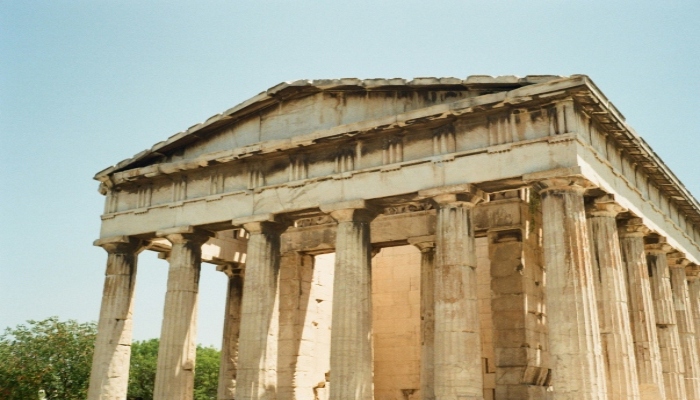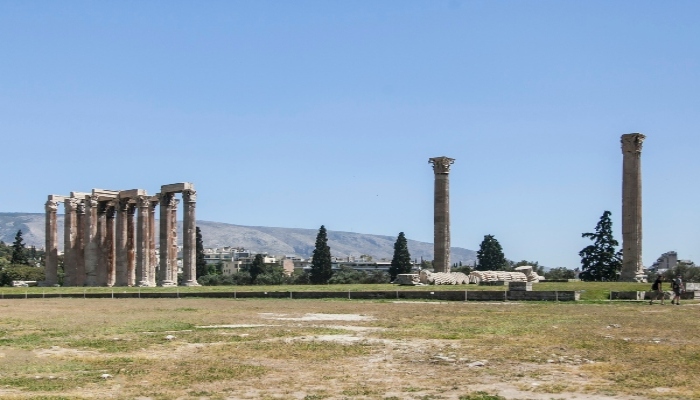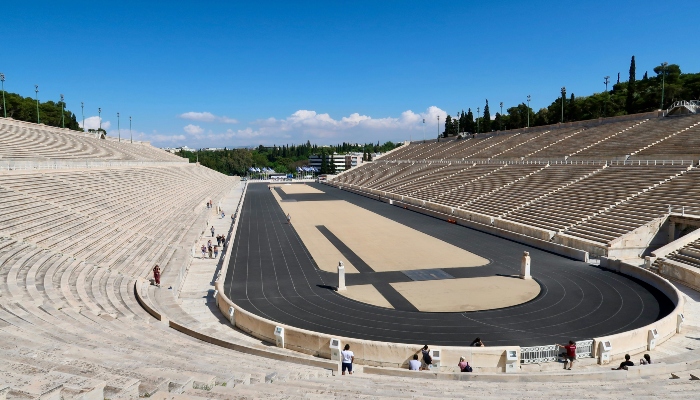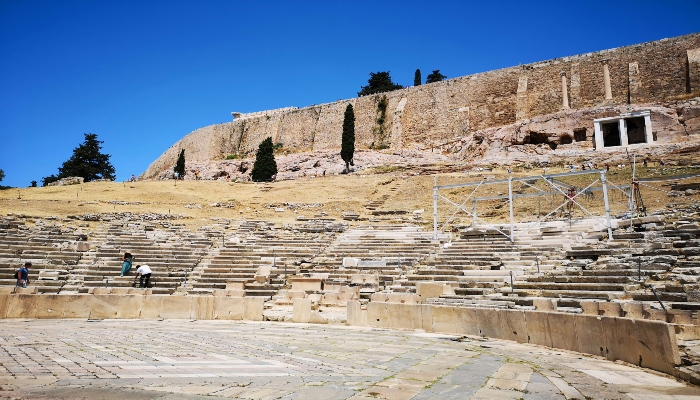Greece. The name conjures images of war movies shown in metallic hues and earthy tones, right? It also whispers the tales of democracy’s birth and artistic innovation. You are likely to read about its captivating history in school. Now, imagine walking the same ground as Socrates and Pericles – exciting, no? Visiting the ancient Athens sites is like stepping directly into those history books. These historical landmarks in Athens offer a tangible connection to a glorious past. Prepare to be awestruck by the enduring legacy of this remarkable civilisation. Our Athens Travel Guide will lead you through seven unmissable treasures. Embark on an unforgettable journey through time and discover the heart of ancient Greece.

Image credit: Spencer Davis for Unsplash
1. The Acropolis and Parthenon: Crown Jewel of Ancient Athens
Perched atop a rocky hill, the Acropolis stands as an enduring symbol. Literally known as ‘high city’ or ‘upper city’, it represents the brilliance of ancient Athens sites. For centuries, the Acropolis has dominated the Athenian skyline since the 5th century BCE. This iconic citadel was once the religious and ceremonial heart of the city, as it housed several temples built during the Golden Age. Its construction showcases incredible architectural prowess, a masterpiece of Doric style.
Highlights:
- The Parthenon is the Acropolis’s most famous structure, a temple which was dedicated to the goddess Athena.
- Marvel at its Doric columns and intricate sculptures.
- Explore other significant structures like the Erechtheion and admire its Caryatids, sculpted female figures supporting the porch.
- Learn the history of this ancient site, including its various landmarks, and get admission to the Acropolis Museum with an audio guide.
- Walk through the Propylaea, the monumental gateway, and imagine the processions and rituals that once took place here.
- Watch breathtaking panoramic views of modern Athens from the Acropolis.
- Explore the nearby Acropolis Museum, which displays original sculptures and artefacts.
Best Time to Visit:
Early morning or late afternoon are ideal. The temperatures are cooler then. Plus, the sunlight enhances the beauty of the marble. However, winter visitors enjoy near-empty pathways and peaceful contemplation. Most importantly, allow at least two hours for a meaningful visit. For a hassle-free experience, always skip the line with this ticket.
2. The Ancient Agora: The Heart of Athenian Life
Below the Acropolis, there lies Athens’ another famous popular attraction, the Ancient Agora. If you want to get a glimpse into daily life in ancient Athens, this place is for you. Once the bustling centre of ancient Athens sites, it served as the city’s marketplace and social hub. According to history, here, citizens gathered to discuss politics and philosophy. As you walk through the complex, the vibe of the place will let you imagine the lively atmosphere that once filled this space. Furthermore, democracy developed and flourished in this very space.
Highlights:
- Explore the remains of various buildings, including the Temple of Hephaestus, one of the best-preserved ancient temples.
- Visit the Stoa of Attalos, now a museum (Agora Museum), which houses artefacts discovered in the Agora.
- Uncover the Church of the Holy Apostles and marvel at another Byzantine architectural contrast.
- Walk along the ancient roads and imagine the merchants and citizens.
- Picture Socrates engaging in philosophical debates here.
Best Time to Visit:
Mid-morning works perfectly for exploring this ancient Athens site. You can also consider visiting in the late afternoon for softer light. The site’s many olive trees offer natural shade throughout. Furthermore, the Agora requires at least 90 minutes for proper exploration. However, history enthusiasts might spend several hours here. Plan accordingly when organising your Athens Greece city tours.

Image credit: Cole Redfearn for Unsplash
3. The Temple of Olympian Zeus: Grandeur on a Monumental Scale
Once the largest temple in Greece, the Temple of Olympian Zeus, also known as the Olympieion or Columns of the Olympian Zeus, was a testament to ambition. Dedicated to Olympian Zeus, the head of the Olympian gods, its construction spanned centuries. Construction began in the 6th century BCE but remained unfinished for centuries. Eventually, Roman Emperor Hadrian completed it some 638 years later. It reflects the power and aspirations of ancient Athens. The massive structure originally featured 104 towering Corinthian columns. However, only 15 columns remain standing today. This ancient Athens site demonstrates both Greek ambition and Roman determination.
Highlights:
- Stand in the presence of the colossal remaining columns.
- Imagine the temple’s original grandeur.
- Visit the nearby Hadrian’s Arch, a Roman-era gateway, which marks the transition between the ancient and Roman cities.
- Take photos of these impressive remnants.
Best Time to Visit:
Sunrise and sunset can cast dramatic shadows on the ruins. The site has minimal shade, so avoid midday summer visits. Additionally, the relatively compact area requires only about 45 minutes. Most Athens tours include this spectacular ancient Athens site.

Image credit: Athens at a Glance for Unsplash
4. The Panathenaic Stadium: Where Ancient Athletes Competed
A must-see in Athens, the Panathenaic Stadium boasts a rich history. It shines as the world’s only all-marble stadium. Ancient Athenians built the original structure around 330 BCE. Later, it underwent complete renovation for the 1896 Olympic Games. Furthermore, this renovation revived the Olympic tradition for the modern era. The stadium hosted athletic competitions for the Panathenaic festivals. Additionally, its distinctive horseshoe shape could seat 50,000 spectators. This ancient Athens site creates a powerful link between past and present.
Highlights:
- Walk on the track where ancient athletes once competed.
- Imagine the roar of the crowds.
- Explore the stadium’s seating and envision the events.
- Climb to the top for panoramic city views.
- Visit the small museum that displays Olympic torches and memorabilia.
Best Time to Visit:
Visit during cooler parts of the day, especially in summer. Early morning or late afternoon are best for avoiding heat. The site requires approximately one hour for a thorough visit. Moreover, photographers should consider sunset visits for golden lighting effects.

Image credit: Julio Hernández for Unsplash
5. Hadrian’s Library: A Centre of Knowledge in Ancient Athens
Hadrian’s Library was more than just a repository of scrolls. It was a significant cultural centre in ancient Athens. Roman Emperor Hadrian built this massive complex in 132 CE. The facility housed thousands of papyrus scrolls and manuscripts. Additionally, it provided lecture halls and meeting spaces for scholars. The emperor’s philhellenism (love of Greek culture) motivated this project. Furthermore, the library represented the fusion of Greek and Roman civilisations. This ancient Athens site demonstrated Rome’s respect for Athenian intellectual traditions.
Highlights:
- Explore the remaining walls and columns and imagine the grand scale of the library.
- Picture scholars studying and discussing knowledge here.
- Soak in the glimpse into the intellectual life of the city.
- Consider the importance of libraries in the ancient world.
Best Time to Visit:
Mid-morning provides comfortable exploration conditions for this ancient Athens site. The compact site requires approximately 45 minutes for careful examination. Furthermore, the surrounding Monastiraki area offers excellent lunch options afterwards. Many must-see in Athens itineraries include this important cultural landmark.

Image credit: Saara Sanamo for Unsplash
6. The Theatre of Dionysus: The Birthplace of Drama
Located on the slopes of the Acropolis, the Theatre of Dionysus holds immense significance. A crucial stop on any Athens tour, it is considered the birthplace of Western drama. Furthermore, the masterpieces of Aeschylus, Sophocles, and Euripides premiered here. Athenians built the original theatre in the 6th century BCE. Additionally, it could accommodate up to 17,000 spectators. The annual Great Dionysia festival centred around this performance space. Consequently, theatre arts developed and flourished in this very location.
Highlights:
- Visualise the ancient plays performed in this very spot and imagine the audience watching the tragedies and comedies.
- Explore the remains of the stage and seating areas.
- Consider the impact of Athenian theatre on Western culture.
Best Time to Visit:
Morning visits work well for this south-facing ancient Athens site. The theatre requires approximately one hour for proper appreciation. Additionally, its location on the Acropolis’ southern slope makes it easily combinable.

Image credit: Marco Montero Pisani for Unsplash
7. The Ancient Gymnasia of Athens & the Lykeion: Training Grounds for Body and Mind
The ancient gymnasia were vital institutions in ancient Athens. Young men received physical, intellectual, and moral instruction here. Furthermore, the Lykeion (Lyceum) gained fame as Aristotle’s philosophical school. He established this institution in 335 BCE. Additionally, students engaged in “peripatetic” (walking) discussions here. Archaeological excavations revealed the site only in 1996. Consequently, this ancient Athens site represents a relatively recent discovery.
Highlights:
- Explore the archaeological remains of these important sites, including the Lykeion ruins that reveal the palaestra (wrestling area) foundations.
- Imagine young Athenians exercising and learning.
- Consider the holistic approach to education in ancient Greece. The Lykeion holds particular significance due to its connection to Aristotle.
- Opt for a guided sightseeing tour and discover Athens with this popular ancient attraction.
Best Time to Visit:
This less-visited ancient Athens site works well for afternoon exploration. The area requires approximately one hour. Furthermore, its location near the National Garden provides cooling afterwards. Few Athens Greece city tours include this specialised site. However, philosophy enthusiasts find it particularly meaningful. Wear comfortable shoes, as you’ll be walking on uneven ground.
Navigating the Wonders: Tips for Your Athens Adventure
- Exploring the historical landmarks in Athens is an incredible experience. To make your trip even smoother, consider a hop-on hop-off Athens bus tour. This is a fantastic way to navigate the city’s key ancient Athens sites efficiently.
- Stay hydrated, especially during the warmer months.
- Don’t forget your sunscreen and a hat.
- Embrace the opportunity to wander and discover hidden gems within these ancient Athens sites.
- After completing your ancient Athens adventure, opt for a night sightseeing and explore the city from a different perspective.

Image credit: Vitor Paladini for Unsplash
Conclusion: A Journey Through Time in Ancient Athens
These seven ancient Athens sites offer extraordinary connections to Western civilisation’s roots. Athens preserves these treasures with remarkable care and accessibility so that visitors gain invaluable insights into its cultural foundations. If you want to explore Athens seriously, then you should allocate at least three days for proper exploration. However, don’t presume Athens has only these ancient sites to explore; it offers an endless list of things to do. From a sunset dinner cruise to a food-guided tour, the list is really long.
Book your Athens tours and prepare to be amazed by the enduring legacy of this extraordinary city. The must-see in Athens are waiting to tell their stories.


